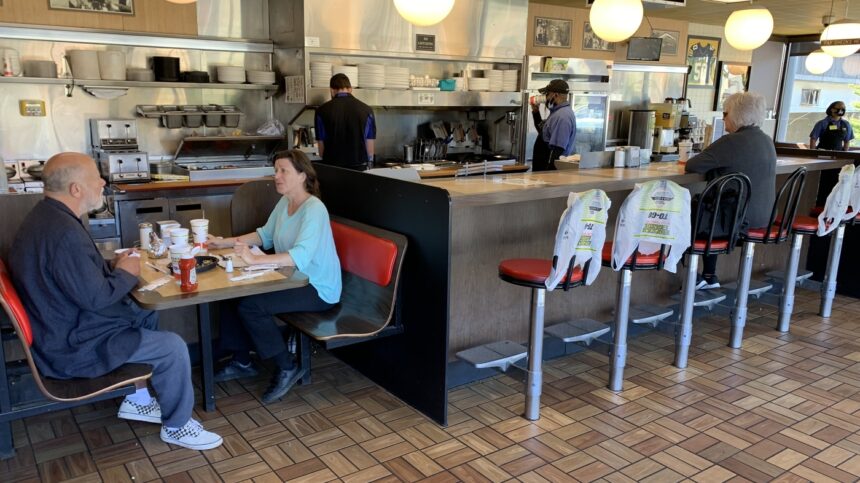
Restaurant prices rose 4.2% over the last year. But Americans continue to dine out regularly.
Michael Mathes/AFP via Getty Images
hide caption
toggle caption
Michael Mathes/AFP via Getty Images

The Federal Reserve has promised to be “data driven” in deciding when to cut interest rates. But some of the recent economic data has the central bank driving in circles.
Economic growth is slowing. But hiring appears to be picking up. Cars are getting cheaper but auto insurance is more expensive. Inflation is lower than it was a year ago but higher than it was last month.
As they try to sift through sometimes contradictory economic signals, Fed policymakers are likely to stick with their go-slow approach, leaving interest rates unchanged this week — and possibly for months to come.
“If you want to join the kennel of data dogs, what’s the first rule of the kennel?” Chicago Fed president Austan Goolsbee said recently. “If you are unclear, stop walking and start sniffing. And with these numbers, we need to do more sniffing.”
Inflation fell sharply in the second half of last year, leading some to believe the Fed would soon be ready to take its foot off the brake and start cutting interest rates. But that progress on prices has since slowed, and Fed watchers now expect the Fed to keep its benchmark interest rate at a 23-year high, at least through the summer.
“I think we have to recalibrate,” Goolsbee said. “It doesn’t look like it’s going to be as rapid as it looked for the previous six or seven months.”
Inflation numbers released by the Commerce Department last week showed prices climbing 2.7% during the 12 months ending in March — the biggest annual increase in four months. Former White House economist Ernie Tedeschi says he’s not worried that inflation is picking up steam, but he agrees with Goolsbee that it’s no longer cooling.
“I think it’s clear at this point that the progress that we’ve made lowering inflation towards [the Fed’s 2%] target has stalled,” says Tedeschi, who’s now director of economics at the Yale Budget Lab. “This is a good challenge for the Fed, although certainly a challenge. What’s underpinning the Fed’s concern and mystery is economic strength, not economic weakness.”
The job market remains strong, with unemployment under 4%. And while the economy grew more slowly in the first three months of the year than forecasters expected, consumer spending is still robust.
Higher interest rates have cut into spending on big-ticket items. But spending on services continues to increase.
“You typically take out a loan for when you make a big goods purchase, like a car, certainly a house,” Tedeschi says. “Services spending is generally less interest rate-sensitive.”
So while the Fed can influence demand for cars and houses by adjusting interest rates, its ability to tamp down demand for restaurant meals or concert tickets is more limited.
“We have one tool, basically,” Goolsbee said, referring to interest rates. “If you ask the question, ‘How interest rate-sensitive are elective plastic surgeries?’ I have no idea. So we’re trying to match our tools to the moment and that’s not totally straightforward.”
What’s more, many Americans are largely insulated from the Fed’s high interest rates, if they don’t carry a balance on their credit card and they locked in a low, fixed interest rate on their mortgage.
“That’s one of the reasons why the consumer remains fairly willing to go out to restaurants and go to the mall,” says Oren Klachkin, financial market economist at Nationwide. “They’re not feeling that pain of the high-rate environment. Of course, that means that inflation is not going to come down as fast. But that’s kind of the tradeoff that we’re in right now.”
Federal Reserve chairman Jerome Powell has said the central bank can afford to be patient in battling inflation, since high interest rates have so far not hurt the job market. U.S. employers added an average of 276,000 jobs a month in January, February and March — up from 212,000 jobs on average in the three previous months. (April jobs numbers will be released on Friday.)
Employers’ cost for labor rose 4.2% in the 12 months ending in March, according to figures released Monday by the Labor Department. While rising wages could put more upward pressure on prices, they’re also a big reason that people keep spending money.
“They have jobs. Their wages are increasing,” Klachkin says. “It’s not to say that there’s not risks. We’re seeing credit card delinquencies increase. The savings rate is quite low. This leaves them fairly exposed if and when the labor market does soften. But until that happens, the consumer is going to remain in a spending mood.”




